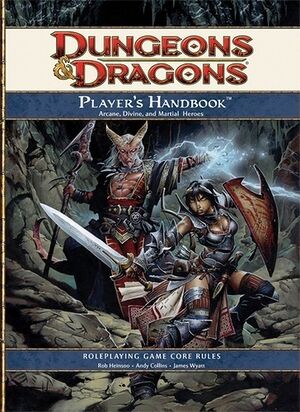Dungeons & Dragons 4th Edition






System
The fourth edition of Dungeons & Dragons, the grand daddy of RPGs.
Basics
Nearly every roll consists of making a single D20 roll, plus a modifier, against a target number. Saving throws have been replaced with Defenses that work like AC; the term 'Saving Throw' is now used to refer to a roll to recover from a durational effect.
Character Generation
Chargen is simplified compared to 3rd Edition (although still time consuming) - skills are all-or-nothing, you either have training in them or you don't. Each character gains a selection of Powers which can be used at will, once per encounter, or once per day, in ascending order of power. These abilities often consist of an attack plus some special effect, such as knocking someone prone, setting them on fire, or moving yourself or your opponent. There are also five possible alignments, none of which have much effect on gameplay any more: Lawful Good, Good, Unaligned, Evil and Chaotic Evil. So all you chaotic good drow rip-offs are gone.
The character races in the PHB are:
In addition to the races in the PHB, the following player races are in the MM and other sourcebooks: (all of them are "LA +0", to put things in 3.5 parlance):
- Bladeling
- Bugbear
- Bullywug
- Doppelganger
- Drow
- Duergar
- Genasi (comes in 5 varieties: Earthsoul, Firesoul, Stormsoul, Watersoul, and Windsoul)
- Githyanki
- Githzerai
- Goblin
- Gnolls
- Gnome
- Hobgoblin
- Kenku
- Kobold
- Minotaur
- Orc
- Shadar-Kai
- Shifter, Longtooth
- Shifter, Razorclaw
- Warforged (updated and in this article of Dragon Magazine #364)
Character races in the PHB 2 are:
Character classes in the first PHB consist of:
- Cleric (Role: Leader, Power Source: Divine)
- Fighter (Role: Defender, Power Source: Martial)
- Paladin (Role: Defender, Power Source: Divine)
- Ranger (Role: Striker, Power Source: Martial)
- Rogue (Role: Striker, Power Source: Martial)
- Warlock (Role: Striker, Power Source: Arcane)
- Warlord (Role: Leader, Power Source: Martial)
- Wizard (Role: Controller, Power Source: Arcane)
Classes from the second PHB are:
- Avenger (Role: Striker, Power Source: Divine)
- Barbarian (Role: Striker, Power Source: Primal)
- Bard (Role: Leader, Power Source: Arcane)
- Druid (Role: Controller, Power Source: Primal)
- Invoker (Role: Controller, Power Source: Divine)
- Shaman (Role: Leader, Power Source: Primal)
- Sorcerer (Role: Striker, Power Source: Arcane)
- Warden (Role: Defender, Power Source: Primal)
Classes in other books include:
Gameplay
Gameplay is divided into encounters. The GM selects monsters and traps up to a total experience value as recommended for the size of the party, and the encounter plays out as a tactical miniatures game. Non-combat encounters consist of "skill challenges", where skill checks (sometimes of multiple types) are made in sequence. XP is awarded for non-combat challenges and quests, as well as for combat encounters.
Each character can take one standard action (such as an attack), one move action, one minor action, and any number of free actions per turn. Each character also gets one immediate interrupt or immediate reaction per round, which may be used outside of the regular turn order. Generally each character will use their standard action to make use of an attack power. Characters are highly specialised as noted above, and fit into MMO-style combat roles of controller (lockdown/AoE), defender (tank), leader (buffer/healer), striker (DPS).
Characters level up from level 1 to 30; with the scope of the game changing every ten levels. At level 30 characters are expected to undergo some form of apotheosis.
Setting
The setting of 4e is highly generic and designed to give the DM a relatively blank canvas to paint on. This default setting consists of a wild medieval landscape in which isolated human and demihuman communities ('Points of Light') struggle to survive after the fall of a greater empire. This provides an explanation for the large areas of wilderness and many ruins for monsters to hide in, and the need for adventurers as opposed to more regulated militias. Which doesn't make any Goddamn sense, but okay.
The Planescape cosmology, present in 2e and 3e, has been removed, and a much vaguer "Astral Sea" cosmology has been put in its place.
The DMG contains an extensive section explaining the tropes of the setting and how they might be used, and also suggesting ways in which the DM can deviate from them to make the setting his own.
D&D 4e on /tg/
Since its announcement 4e has been a source of controversy and trolling on /tg/. Its supporters consider it to have made D&D simple and fun. Its critics have numerous objections to the system and setting, often referring to it as 'shit twinkie' (with the implication that they had been expecting a certain type of D&D goodness and sorely disappointed by what was actually delivered.)
It is virtually guaranteed that any 4e thread will descend into trolling within the first dozen replies.
Criticism
Some of the criticisms leveled at 4e include:
- HHHHHHHHHHHHHHHHHHHHHHHHHHHHHHHHHHHHHHHHHHHHHHHHHHHHHHHHHHHHHHHHHHHHHNNNNNNNNNNNNNNNNNNNNNNNNNNNNNNNNNNNNNNNNNNNNNNNNNNNNNNNNNNNNNNNNNNNNGGGGGGGGGGGGGGGGGGGGGGGGGGGGGGGGGGGGGGGGGGGGGHHHHHHHHHHHHHHHHHHHHHHHHHHHHH huh HU-HNNNNNNNNNNNNNNNNNNNNNNNNNNNNNNNNNNNGGGGGGGGGGGGGGGGGGGGGGGGGGGGGGGGGGGGGGGGGGGGGGGGGGGGGGGGGGGGGGGGGGGGGGGGGGGGGGGGGGGGGGGGGGGGGGGGGGGGGGGGGGGGGGGGGGGGGGGGGGGGuh. H-HURP DURP DURP
HURR HURR
See also
- Dungeons & Dragons
- Advanced Dungeons & Dragons
- Dungeons & Dragons 3rd Edition
- Touhou Power Cards
- Rage
- Troll